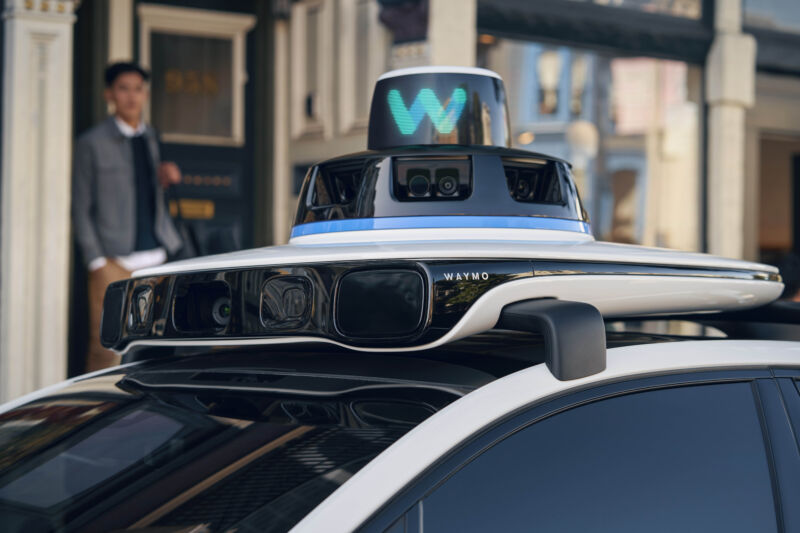Waymo says its cars cause injuries six times less often than human drivers.

Waymo on Wednesday released new crash data based on the company’s first 7.1 million miles of fully driverless operations in Arizona and California. The data show that human-driven cars are more than twice as likely to get into a crash that is reported to the police. And depending on how you do the math, human-driven cars are four to seven times more likely to get into crashes that lead to an injury.
Through October 2023, driverless Waymo vehicles have had only three crashes with injuries—two in the Phoenix area and one in San Francisco. Waymo says all three injuries were minor. If those same miles had been driven by typical human drivers in the same cities, we would have expected around 13 injury crashes.
The new data comes at a crucial time for the self-driving industry. In October, a woman was dragged about 20 feet underneath a vehicle by Waymo’s main rival, Cruise. Since then, Cruise has lost its CEO, laid off 24 percent of its workforce, and suspended driverless operations nationwide.
Cruise’s implosion has left Waymo as the undisputed leader in the driverless taxi market. But it has also heightened public skepticism about self-driving technology in general. So Waymo is going to have to work hard to convince the public that its technology not only has the potential to make the roads safer in the future, but is already doing so now.
The new data provides Waymo fresh ammunition to make that case. If Waymo can maintain its excellent safety record in the coming months and years, it will have a strong argument for continued expansion regardless of what happens in the rest of the industry.
7 million miles, 3 injuries
Since their inception, Waymo vehicles have driven 5.3 million driverless miles in Phoenix, 1.8 million driverless miles in San Francisco, and a few thousand driverless miles in Los Angeles through the end of October 2023. And during all those miles, there were three crashes serious enough to cause injuries:
- In July, a Waymo in Tempe, Arizona, braked to avoid hitting a downed branch, leading to a three-car pileup. A Waymo passenger was not wearing a seatbelt (they were sitting on the buckled seatbelt instead) and sustained injuries that Waymo described as minor.
- In August, a Waymo at an intersection “began to proceed forward” but then “slowed to a stop” and was hit from behind by an SUV. The SUV left the scene without exchanging information, and a Waymo passenger reported minor injuries.
- In October, a Waymo vehicle in Chandler, Arizona, was traveling in the left lane when it detected another vehicle approaching from behind at high speed. The Waymo tried to accelerate to avoid a collision but got hit from behind. Again, there was an injury, but Waymo described it as minor.
The two Arizona injuries over 5.3 million miles works out to 0.38 injuries per million vehicle miles. One San Francisco injury over 1.75 million miles equals 0.57 injuries per million vehicle miles. An important question is whether that’s more or less than you’d expect from a human-driven vehicle.
After making certain adjustments—including the fact that driverless Waymo vehicles do not travel on freeways—Waymo calculates that comparable human drivers reported 1.29 injury crashes per million miles in Phoenix and 3.79 injury crashes per million miles in San Francisco. In other words, human drivers get into injury crashes three times as often as Waymo in the Phoenix area and six times as often in San Francisco.
Waymo argues that these figures actually understate the gap because human drivers don’t report all crashes. Independent studies have estimated that about a third of injury crashes go unreported. After adjusting for these and other reporting biases, Waymo estimates that human-driven vehicles actually get into five times as many injury crashes in Phoenix and nine times as many in San Francisco.
To help evaluate the study, I talked to David Zuby, the chief research officer at the Insurance Institute for Highway Safety. The IIHS is a well-respected non-profit that is funded by the insurance industry, which has a strong interest in promoting automotive safety.
While Zuby had some quibbles with some details of Waymo’s methodology, he was generally positive about the study. Zuby agrees with Waymo that human drivers underreport crashes relative to Waymo. But it’s hard to estimate this underreporting rate with any precision. Ultimately, Zuby believes that the true rate of crashes for human-driven vehicles lies somewhere between Waymo’s adjusted and unadjusted figures.
Other data points in the same direction
Waymo’s new study focuses on crashes that are reported to the police. A September study from Waymo took a different approach, focusing on crashes that were reported to insurance companies. A fair number of crashes don’t get reported to the police but lead to an insurance claim. So, insurance records provide a more comprehensive way to estimate the crash rates of human drivers. Waymo partnered with Swiss Re, a reinsurance company that has access to a comprehensive database of insurance claims.
The Swiss Re study was based on 3.8 million miles of driving between Phoenix and San Francisco up through August 1. And it came to conclusions similar to Waymo’s new study. Swiss Re found that human-driven vehicles got into crashes involving property damage four times as often as Waymo vehicles.
Waymo hadn’t had any injury-related insurance claims by the study’s August 1 cutoff date (it’s unclear what happened to the July injury mentioned above). By comparison, a typical human driver would have been involved in more than three crashes involving bodily injury claims over 3.8 million miles of driving.
The big unknown: fatal crashes
Seven million driverless miles of real-world driving gives us some information about the safety of Waymo vehicles. But it’s not enough to answer the most important safety question: whether Waymo’s technology makes fatal crashes less likely.
This is a hard question to answer because fatal crashes only occur on the road about once every 100 million miles. This means that we’re going to need to test driverless vehicles for hundreds of millions—if not billions—of miles before we can be sure whether they cause fewer fatal crashes than human drivers.
You might think you could extrapolate from statistics about non-fatal crashes—and so far, those numbers look pretty good for Waymo. But Zuby told me that it’s not that simple.
“When you look at reports of fatal crashes a lot of them are just completely bizarre,” Zuby told me. Moreover, he said, AVs may have dramatically different failure modes than human drivers. Waymo’s technology helps eliminate situations like drunk driving that are responsible for a lot of fatal crashes. But the technology might have other failure modes that its designers haven’t anticipated.
So that leaves us in a somewhat uncomfortable place: All the data so far suggests that Waymo vehicles are making roads in San Francisco and Phoenix at least a little bit safer. And Waymo’s case gets stronger with every million miles it completes. But it’s going to be another couple of years—if not longer—before we can be confident about whether Waymo vehicles are helping to reduce the risk of fatal crashes.
Tim Lee was on staff at Ars from 2017 to 2021. He recently launched a new newsletter, Understanding AI. It explores how AI works and how it’s changing our world. You can subscribe to his newsletter here.




